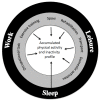Exercise Prescription for the Work-Life Population and Beyond
- PMID: 37367237
- PMCID: PMC10299214
- DOI: 10.3390/jfmk8020073
Exercise Prescription for the Work-Life Population and Beyond
Abstract
The background for this paper concerns a high frequency of work-related disorders that may result from physical exposure at work being highly sedentary, repetitive-monotonous, or physically demanding. This may result in levels of physical inactivity or strenuous activity impairing health. The aim is to present an evidence-based exercise prescription for the work-life population and beyond. The exercise program is designed to be feasible for use at the workplace and/or during leisure time and to improve health, workability, productivity, sickness absence, etc. The specific concept of Intelligent Physical Exercise Training, IPET, includes the assessment of several health-related variables, including musculoskeletal disorders, physical capacity, and physical exposure at work and/or daily life activity. An algorithm with cut-points for prescribing specific exercises is provided. Exercise programs in praxis are addressed through descriptions of precise executions of various prescribed exercises and possible alternatives to optimize variation and adherence. Finally, perspectives on the significance of introducing IPET and the ongoing, as well as future lines of development, are discussed.
Keywords: cardiovascular fitness; exercise interventions; musculoskeletal disorders; musculoskeletal pain; physical capacity; physical exercise training; resistance training; strength training; workplace health promotion.
Conflict of interest statement
The authors declare no conflict of interest.
Figures





Similar articles
-
A conceptual model for worksite intelligent physical exercise training--IPET--intervention for decreasing life style health risk indicators among employees: a randomized controlled trial.BMC Public Health. 2014 Jun 26;14:652. doi: 10.1186/1471-2458-14-652. BMC Public Health. 2014. PMID: 24964869 Free PMC article. Clinical Trial.
-
The elixir of muscle activity and kinesiology in a health perspective: Evidence of worksite tailored exercise training alleviating muscle disorders.J Electromyogr Kinesiol. 2021 Dec;61:102600. doi: 10.1016/j.jelekin.2021.102600. Epub 2021 Sep 16. J Electromyogr Kinesiol. 2021. PMID: 34563760
-
Background, design and conceptual model of the cluster randomized multiple-component workplace study: FRamed Intervention to Decrease Occupational Muscle pain - "FRIDOM".BMC Public Health. 2016 Oct 24;16(1):1116. doi: 10.1186/s12889-016-3758-6. BMC Public Health. 2016. PMID: 27776506 Free PMC article. Clinical Trial.
-
Exercise is more than medicine: The working age population's well-being and productivity.J Sport Health Sci. 2016 Jun;5(2):159-165. doi: 10.1016/j.jshs.2016.04.004. Epub 2016 Apr 7. J Sport Health Sci. 2016. PMID: 30356522 Free PMC article. Review.
-
The effectiveness of workplace nutrition and physical activity interventions in improving productivity, work performance and workability: a systematic review.BMC Public Health. 2019 Dec 12;19(1):1676. doi: 10.1186/s12889-019-8033-1. BMC Public Health. 2019. PMID: 31830955 Free PMC article.
Cited by
-
"Back Health 24/7/365"-A Novel, Comprehensive "One Size Fits All" Workplace Health Promotion Intervention for Occupational Back Health among Hospital Employees.Int J Environ Res Public Health. 2024 Jun 14;21(6):772. doi: 10.3390/ijerph21060772. Int J Environ Res Public Health. 2024. PMID: 38929018 Free PMC article.
-
Factors for adherence to a physical activity promotion program in the workplace: a systematic review.BMC Public Health. 2025 May 17;25(1):1827. doi: 10.1186/s12889-025-22775-4. BMC Public Health. 2025. PMID: 40382548 Free PMC article.
References
-
- Pedersen B.K., Andersen L.B. Fysisk Aktivitet—Håndbog om Forebyggelse. Sundhedsstyrelsen; København, Denmark: 2018.
-
- Holtermann A., Marott J.L., Gyntelberg F., Sogaard K., Suadicani P., Mortensen O.S., Prescott E., Schnohr P. Does the benefit on survival from leisure time physical activity depend on physical activity at work? A prospective cohort study. PLoS ONE. 2013;8:e54548. doi: 10.1371/journal.pone.0054548. - DOI - PMC - PubMed
-
- Lavin K.M., Coen P.M., Baptista L.C., Bell M.B., Drummer D., Harper S.A., Lixandrao M.E., McAdam J.S., O’Bryan S.M., Ramos S., et al. State of Knowledge on Molecular Adaptations to Exercise in Humans: Historical Perspectives and Future Directions. Compr. Physiol. 2022;12:3193–3279. doi: 10.1002/cphy.c200033. - DOI - PMC - PubMed
Publication types
LinkOut - more resources
Full Text Sources
Medical

